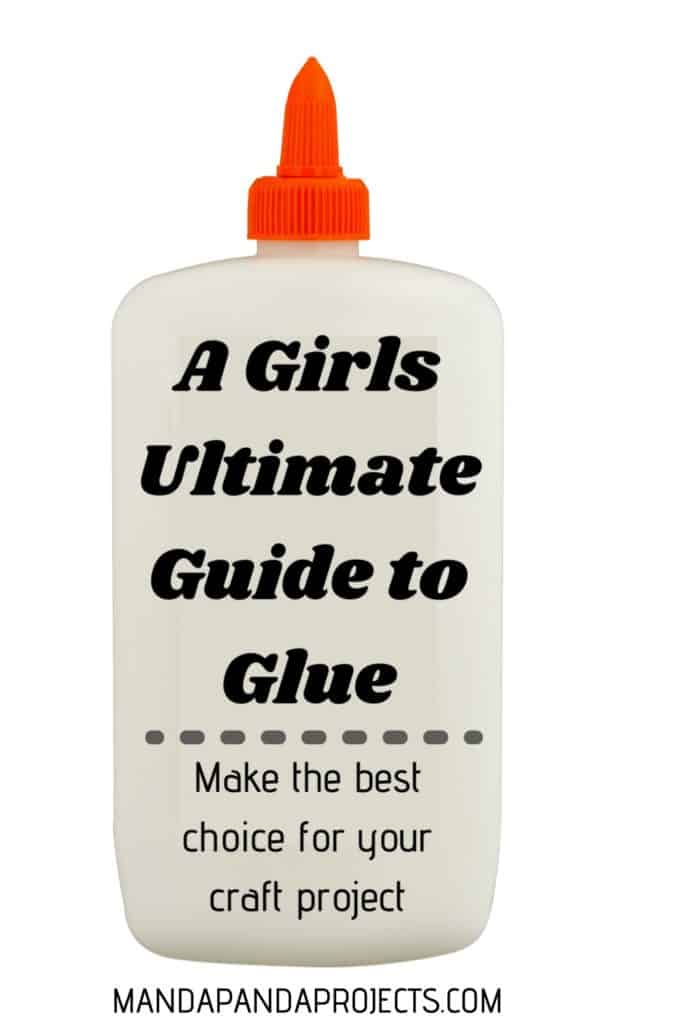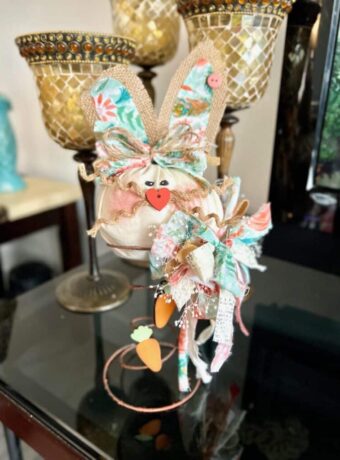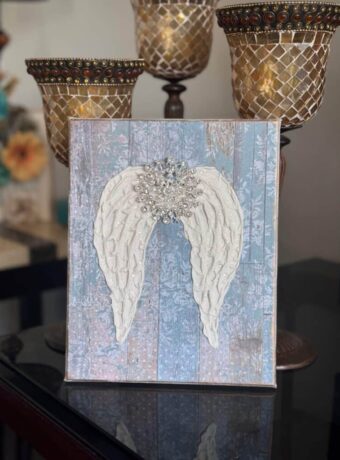With so many glues to choose from it’s so hard to know exactly which one is the best glue for crafts and DIY projects! This ultimate guide outlines what materials work with each, drying times, qualities and properties, as well as how to best remove it. This guide leaves no glue question unanswered!
 Glue is an absolute staple of any household that crafts. It is one of the 7 essential crafting supplies that you can’t live without, whether you’re just a beginner or an expert level crafter!
Glue is an absolute staple of any household that crafts. It is one of the 7 essential crafting supplies that you can’t live without, whether you’re just a beginner or an expert level crafter!
The problem is, there are so many types of glue out there it’s nearly impossible to know which one is the best glue for your craft project. I have tried every single type of glue under the sun, for every single type of project I’ve done, and I want to help you decide which one to choose for your project without having to do eenie meenie miney moe!
In this comprehensive guide to all things sticky, I’ll review what types of projects each glue is best for, what materials it works with, drying time, and even how to remove it!
I’ve even went ahead and made a cute little printable guide so that you can keep it handy in your craft room (or corner like me) to reference next time your glue choice is in question! You can get the printable guide as a little thank you gift for signing up to our newsletter below.
This post may contain affiliate links for your convenience (which means if you make a purchase after clicking a link I will earn a small commission but it won’t cost you a cent more!)
What are the best types of glue used for crafting?
There are so many types of glue out there that we would be here ’til the next millennium if I tried to list every single one. Here I’ll include all of the most popular ones, as well as the ones that I feel are personally the best, and which to stay away from. I’ll link to each specific brand that I use on the regular, so that you don’t have to go hunting through the aisles on your next Target run. Most importantly, you’ll never have to ask yourself “What is the best glue for crafts?” again!
- E6000
- Tacky Glue
- Glue Gun
- Elmers Craft Glue
- Glue Stick
- Super Glue
- Mod Podge
- Wood Glue
- Glue Dots
- Fabric Glue
- Spray Adhesive
This guide is simply my personal review and opinions, so please always read the instructions that come with each glue for the most current uses.
What is the best glue for my craft project?
There are a few things to consider when choosing the right glue to use. Of course the obvious-what do you need it to stick to, but also ease of use, dry time, and whether or not it’s removable.
E6000
This is one of my go-to glues for anything that I need a super strong permanent bond. I use it for DIY home projects, wreaths, repairing broken glass, or metal frames, and anything I want to stick FOREVER. If I am working with a material that no other glue seems to stick, guaranteed E6000 will do the trick. It is even waterproof. It does have very strong odor so you need to use it in a ventilated area, making it a bad choice for kids to use or when doing school projects.
Materials
Metal, glass, wood, fiberglass, ceramics, vinyl, plastic, leather, rubber. I would NOT use it on Styrofoam. I did this once, and it ate right through the material, just dissolved it right away!
Dry Time
Starts to become tacky after 2 minutes and can take up to 24-48 hours to be completely bonded. This is good because it gives you time to readjust positioning if needed but certainly does not provide quick fixes.
Removal
Acetone nail polish remover is just about the only household thing that will remove this ultra strong adhesive. Apply generously to a rag and rub the area until it begins to dissolve. Even then, remnants of the glue may be noticeable, so do not use this one if you think theres a chance it may need to be removed.
Glue Dots
This one is my go-to for all things kid safe. I use it for paper crafts, school projects, and other simple kids crafts. It works similar to double-sided tape, except I think it holds better and is easier to work with. It is clean, non-toxic, odorless, and safe, making it a great choice when crafting with the kiddos. I like how it comes in permanent and removable, and in a variety of sizes as well.
Materials
Paper, plastic, foil, glass, foam, wood.
Dry Time
Instant!
Removal
The removable type is, well, easily removable. Although I haven’t done so myself, I’ve read that the permanent kind can be removed using a cotton swab and Artist Adhesive remover. Pricking the surface with a pin can accelerate the process by allowing the remover to penetrate the surface.
Tacky Glue
Aleene’s original has been around forever. It’s your household waterbased craft glue. I think of it has the Adult version of Elmer’s school glue, except its just a bit thicker. It dries clear, has a strong hold, and its non-toxic making it a good choice for kids projects. In fact, I’d say you don’t even need to have both Aleene’s and Elmers bon hand because Aleene’s does the job of both (better). When gluing paper to paper with tacky glue, you want to apply only a thin layer because it can soak right through the paper and you don’t want wrinkles.
Materials
Paper, foam, felt, wood, ceramics, fabric, vinyl, glass.
Dry time
Starts to become tacky after 1 minute, and drys completely in about 35 minutes.
Removal
Tacky glue is fairly easy to remove, especially in comparison to some of the permanent glues in this list. If it has not completely dried, a cloth with warm soapy water will take it right off. Once it has dried, it can be removed by putting some acetone nail polish remover on a cotton swab and gently rubbing the area.
Glue Stick
Yet another staple to my craft supply stash. These are THE best for kids because they’re virtually mess free. They are non-toxic and work with any type of paper craft. I use them for art projects, scrapbooking and applying labels. But the materials end there.
Materials
Paper.
Dry time
Less than 5 minutes and a thin layer will dry within 2.
Removal
Comes off easily with a rag and warm, soapy water.
Mod Podge
Oh the things you can do with this one! I primarily use this for decoupaging and scrapbooking because it holds well and is safe for photos. It’s also good for gluing puzzles and can be used as a sealer that protects acrylic paint, stain, fabrics, just to name a few. It really is an all-in-one glue, sealer, and finish! It is non-toxic, and dries clear, so it is not a bad choice for kids besides that fact that it can get a bit messy as it comes in a jar with a large open mouth.
Materials
Paper, fabric, wood, glass, metal, plastic, ceramic.
Dry time
It may seem as if its dry after just about an hour, but it needs a full 24 hours to be truly dry. If your giving something a hard coat, dry time increases to 72 hours.
removal
Comes off easily with a rag and warm, soapy water.
Fabric Glue
This one pretty much speaks for itself. I use it whenever I have a “no-sew” project (think DIY Halloween costumes) or when adhering embellishments to fabric. It’s non-toxic, dries clear, and washable. This particular brand I know also works with a large variety of fabrics.
Materials
Fabric.
Dry time
Depending on the amount used and type of fabric, it takes 2–4 hours to dry, but you should not wash the fabric for 48 hours.
Removal
Before dried, comes off easily with a rag and warm soap and water. Once the glue has dried completely, removal becomes exponentially harder. A product such as Goo Gone may be used with a cotton swab, or acetone nail polisher remover. Apply generously to glue and then scrape away with a butter knife. Remnants may never completely go away.
Hot Glue
I feel like I keep saying this, but yet another must-have glue for any crafter. I use my glue gun for just about anything that hot glue can be used on. They come in a huge variety including low and high temperature, as well as portable, cordless, and corded. The thing about hot glue (which I like) is that you better be sure of what you are gluing because it sets almost instantly leaving minimal room for error. And this may be stating the obvious, but I would not use this choice when crafting with youngin’s since the gun (even the low temp version) does get hot enough to burn those little fingers. One other thing worth mentioning is that hot glue does not do well in cold weather. It just forfeits it’s adhesive power so warm, indoor use it best!
Materials
Fabric, ceramics, leather, paper, foam, wood.
Dry Time
Sets within 5 seconds and up to 30 depending on thickness. Dries completely in under a minute.
Removal
Depending on the surface, you may be able to peel the glue off. For more porous surfaces, dip a cotton swab in rubbing alcohol and rub around the outer edges until it begins to lift and dissolve.
Spray Adhesive
This one is not as widely used since it is only effective with very lightweight materials with a large surface area. I find it best for photos, large poster projects, and anything that I have a large area to cover. It does have an odor, so it must be used in a well ventilated area.
Materials
Lightweight materials, paper cardboard, plastic, films, foam and fiberglass insulation.
Dry Time
Dry time varies widely depending on how porous of a surface and amount used from 1-10 minutes.
Removal
Use a rag wet with rubbing alcohol and wipe surface until clean.
Super Glue
Me and S-G have a love hate relationship. Its a super strong, super fast drying glue, making it very difficult to work with. I don’t use it often and when I do its if I need a quick repair of a household item such as a picture frame, that I will plan to come back and permanently fix at a later time. It has a strong odor, and if it gets on your hands forget it, get used to the feeling because to take it off your taking your skin with it. You cannot leave it out uncovered because it dries up very quickly when left.
Materials
Glass, leather, ceramic, metal, fabric, wood, plastic, paper.
Dry Time
Almost instant. Dries completely within 10 seconds.
Removal
Wet the area with warm soapy water to soften the glue. Saturate a cotton swab with acetone nail polish remover and apply generously. Rub with a file until it begins to come off.
White/School Glue
This is a time tested favorite for everyone. I think of it as the kid proof version of Aleene’s Tacky Glue, as it serves the exact same purpose in a bit of a thinner formula. it dries clear, non-toxic, fairly easy to work with, and easy to clean up, which is why it’s the number one glue used in elementary schools.
Materials
Paper, cardboard, foam, ceramic, fabric, plastic, rubber, wood.
Dry Time
Depending on the amount used, dries completely in 15-30 minutes.
Removal
Comes off easily with a rag and warm soapy water.
Wood Glue
This one speaks for itself as well. It’s the DIY’ers go-to adhesive and it can be used in or outdoors because its completely water resistant. It doesn’t dry completely clear but it does leave a natural wood looking finish. I don’t use this one to often simply because I don’t work with glue much, and when I do I find that E6000 does the trick just as well.
Materials
Wood, fabric, foam, paper, rubber, plastic, ceramics.
Dry Time
20-30 minutes for the item to be held together, and then 24 hours to be completely dried.
Removal
Use a rag wet with rubbing alcohol and gently rub surface until the glue begins to dissolve.
Have you decided which is the best glue for crafts yet? If you have any questions or you find yourself in a sticky situation, drop me a comment below!
Don’t forget to download the visual Girls Glue Guide below to keep handy for when your choice of glue is called into question!
Until Next Time…
Stay Crafty San Diego!















